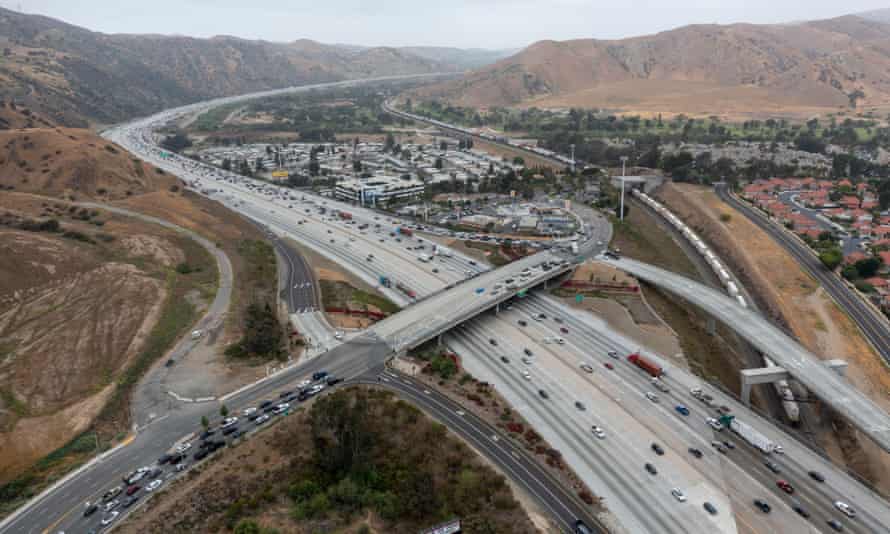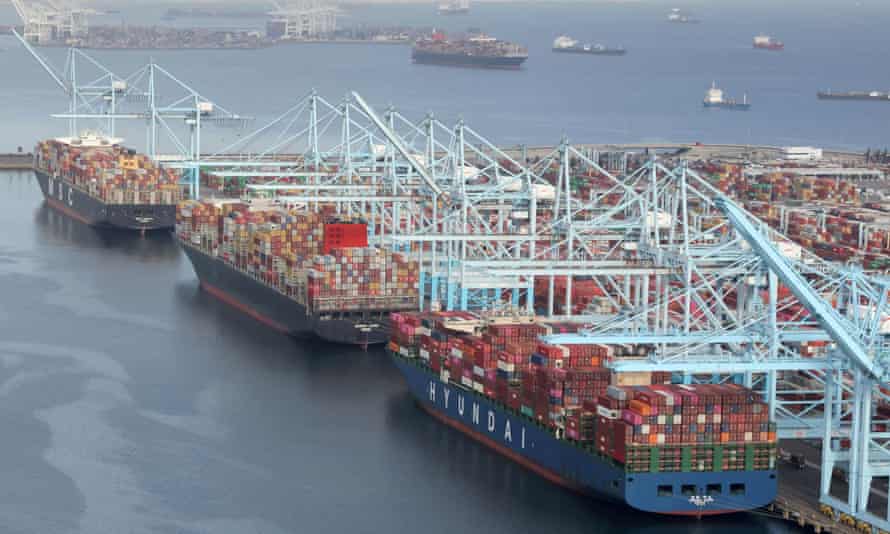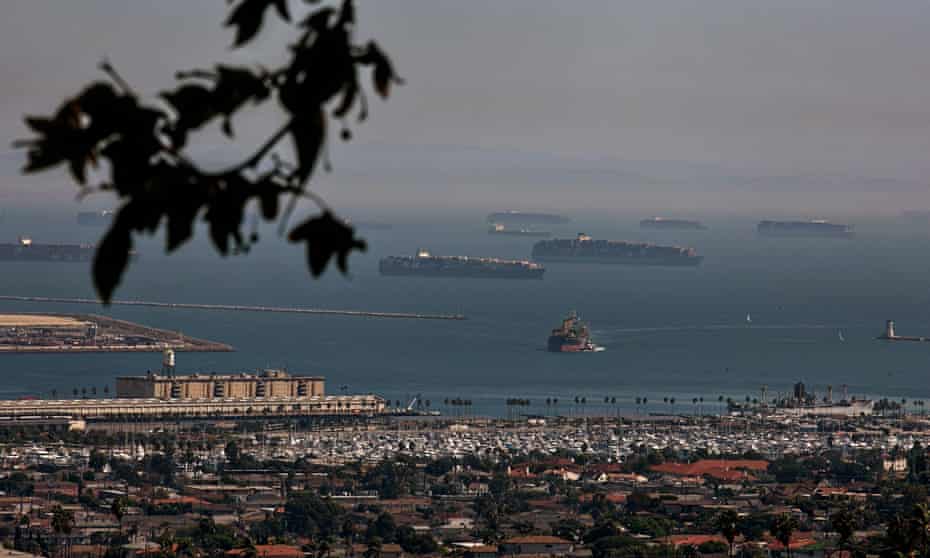Dozens of behemoth cargo ships adorned with tall stacks of brightly colored containers still dot the coastline off southern California. Part of a shipping bottleneck plaguing US ports, the ships – their diesel-fueled engines always ablaze – are also pumping out pollutants as they idle, anchored off-shore.
The clogged supply chain has been described as an economic calamity as the delayed cargo caused shortages in common goods and drove consumer prices higher. But environmentalists and public health advocates are concerned it’s also turning into a climate catastrophe.
The container ships awaiting entry are compounding the levels of contaminants that have long come from the ports and that impact the local environment, coastal communities and ambitious carbon targets needed to curb the worst effects of climate change. With the holiday shopping frenzy just around the corner, there are now concerns the problem may get worse before it gets better.
“The conversation right now is really focused on supply chain backlog and refilling the shelves with products – but that’s not the whole story,” said Madeline Rose, the climate campaign director for Pacific Environment, a climate advocacy organization that has been pushing for retailers to switch to clean energy shipping.
An essential part of the economy, the ports bring in 40% of goods shipped to the US and ship out 30% of its exports, according to state records. The freight system, which includes the trucks, trains and planes that help distribute goods brought over on ships, also generates $9bn in tax revenues for the state and is responsible for a full third of the state’s economy. But it comes at a high cost. The system is also responsible for nearly half of California’s air pollution.
The Ports of Long Beach and Los Angeles, two of the nation’s busiest, create more than 100 tons a day of smog and other cancer-causing contaminants that choke local communities – rivaling roughly 6m cars on the roads across the region each day.

And that was before the backlog.
In previous years, ships could enter the port and receive a berth immediately but for more than a year now, the ports have been packed, leaving between 40 and 60 ships at anchor awaiting entry. In September, the number got into the 70s.
In June, the Port of Los Angeles announced that it processed more than 10m container units over the previous 12-month period, the first port in the western hemisphere to do so. In May alone, the port brought in more than 1m – the most ever seen in its 114-year history. And more is on the way. The port uses a digital technology platform called the Port Optimizer to predict incoming cargo volume months in advance. It shows “significant volume headed our way throughout this year and into 2022”, the Port of Los Angeles executive director, Gene Seroka, said in a statement.
Diesel-powered
While the ships are anchored off-shore they use their auxiliary engines, typically run on diesel fuel, to power essential on-board functions, including refrigeration, lighting and their instruments. This has “substantial implications for portside communities from increased particulate matter (PM) emissions, as well as contributions to smog-forming oxides of nitrogen (NOx)”, according to the California Air Resources Board, which released a report on the problem in June.
Nick Vyas, the executive director of the University of Southern California’s Center for Global Supply Chain Management, said: “We have created a lifestyle where you can click away whatever you want and you can place an order,” but added that behind this convenience are complex supply systems.
The Biden administration announced on Wednesday that it had developed a plan with the Port of Los Angeles to begin operating 24/7 to process the ships faster in an effort to help ease congestion in the backlogged supply chain.
While this may ease congestion on the coast, it won’t have as much of an effect on limiting emissions. “It’s going to take the bubble from the port and move it inland,” Vyas said.

“From the pollution standpoint that may make things worse,” said David Pettit, a senior attorney with the National Resources Defense Council (NDRC), an environmental advocacy group. Roughly 40% of the cargo coming into the ports doesn’t land locally. It is loaded on to diesel trucks that drive it to diesel trains to be trekked off to destinations across the country.
“The communities nearest the port and along the truck routes that serve the port are mostly low-income communities of color,” Pettit added. “They are taking the brunt of the pollution burden while all of us are benefiting from cheap flat-screen TVs from China or Korea or whatever is in those containers.”
For years, frontline communities near the ports have fought for cleaner air. Nearby neighborhoods in Wilmington, San Pedro and West Long Beach have elevated rates of asthma and the area’s highest risks of cancer, even as the ports worked to cut emissions. The poor air quality in some LA county communities also increased fatalities from Covid, with deaths up to 60% higher than areas with better air, according to a study from UCLA. Meanwhile, southern California saw one of the smoggiest years in decades in 2020, according to reporting in the Los Angeles Times.
The ports have adopted collaborative plans to curb emissions set goals to establish zero-emission cargo-handling equipment by 2030 but legislators and advocates are pushing for more action.
Los Angeles city council member Nithya Ramanintroduced a resolution 5 October calling on top importers with ships coming into the San Pedro Port Complex to commit to using zero-emissions ships by 2030. The resolution also requires new plans from the city and state to create infrastructure that decarbonizes shipping lanes across the California coast.
“Our low-income communities of color living near ports are suffering from higher rates of childhood asthma, cancer, and more, and we simply do not have time to waste to reverse the damage” said Raman in a statement.
Representative Michelle Steel, who referred to the anchored ships as “an environmental and public health crisis”, also introduced a bill to ban cargo ships from anchoring off the coast near her district.
As part of a so-called “Ship It Zero” campaign, organizations are applying pressure on major retail companies like Amazon, Target and Walmart to commit to using 100% clean energy shipping by 2030.
Advocates expect the first non-fossil-fueled ships to set sail in the next three to four years but ships typically have a three-decade lifespan so those being built today could still be in use by 2050.





